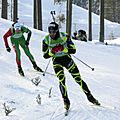Biathlon facts for kids
Biathlon is an exciting winter sport that combines two very different skills: cross-country skiing and rifle shooting. Imagine gliding fast on skis through snowy forests, then stopping, calming your breath, and aiming a rifle at a tiny target! It's a true test of both physical fitness and mental focus. While "biathlon" can mean any sport with two parts, it almost always refers to this unique winter challenge. There's also a summer version that swaps skiing for running.
Contents
What is Biathlon?
Biathlon is a unique sport because it mixes two very different activities:
- Cross-country skiing: This is a tough endurance sport where athletes ski across varied terrain, including uphill climbs, flat sections, and downhill descents. It requires incredible strength and stamina.
- Rifle shooting: This part tests an athlete's precision and calm under pressure. After skiing hard, their heart rate is very high, making it difficult to hold the rifle steady and aim accurately.
Athletes must be fast on their skis and accurate with their shots. Missing targets means getting a penalty, which can be extra skiing or time added to their race.
A Quick Look at Biathlon's History
Biathlon has a long and interesting history. It started in Scandinavia as a way for soldiers to train for winter warfare. Soldiers would ski long distances and then practice shooting targets. This helped them develop skills for surviving and fighting in snowy conditions.
The first known biathlon-like competition took place in Norway in the 18th century. Over time, it grew from a military exercise into a popular sport. It became an official event at the Winter Olympics in 1960.
How Biathlon Races Work
Biathlon races involve several laps of skiing and multiple stops at a shooting range. The exact rules depend on the type of race.
The Skiing Part
Athletes use special lightweight cross-country skis and poles. They ski on groomed tracks that can be flat, hilly, or steep. Skiers use different techniques to move efficiently, like "skate skiing," which looks a bit like ice skating.
The Shooting Part
At the shooting range, athletes shoot at five small targets. The targets are black circles, and they are quite small:
- When shooting from the prone position (lying down), the target is only 4.5 centimeters (about 1.8 inches) wide.
- When shooting from the standing position, the target is 11.5 centimeters (about 4.5 inches) wide.
Athletes use a special .22 caliber rifle that they carry on their back while skiing. They must load each bullet by hand.
Penalties for Missed Shots
Accuracy is super important! If an athlete misses a target, they get a penalty. This can be:
- Skiing a penalty loop: This is an extra 150-meter (about 490-foot) loop that the athlete must ski for each missed target. This takes extra time and energy.
- Adding time: In some races, a fixed amount of time (usually one minute) is added to their total race time for each missed target.
Types of Biathlon Races
There are several exciting formats for biathlon races, each with its own rules and strategies:
Individual Race
This is the oldest biathlon format.
- Athletes start one by one, usually 30 seconds apart.
- They ski five laps and have four shooting stages (alternating prone and standing).
- For every missed target, one minute is added to their total time.
- The athlete with the fastest time wins.
Sprint Race
This is a shorter and faster race.
- Athletes also start individually.
- They ski three laps and have two shooting stages (one prone, one standing).
- For every missed target, they must ski a 150-meter penalty loop.
- The fastest time wins.
Pursuit Race
The start times for this race depend on the results of a previous sprint race.
- The winner of the sprint race starts first.
- Other athletes start behind them based on how far they were behind in the sprint.
- They ski five laps and have four shooting stages (two prone, two standing).
- Each missed target means a 150-meter penalty loop.
- The first athlete to cross the finish line wins.
Mass Start Race
In this exciting race, all athletes start at the same time!
- Only the top athletes from previous races qualify for the mass start.
- They ski five laps and have four shooting stages (two prone, two standing).
- Each missed target means a 150-meter penalty loop.
- The first athlete to cross the finish line wins.
Relay Race
Teams of four athletes compete in a relay.
- Each team member skis three laps and has two shooting stages (one prone, one standing).
- Unlike other races, athletes have three extra bullets they can use for each shooting stage if they miss. If they still miss after using the extra bullets, then they must ski a 150-meter penalty loop for each remaining missed target.
- The first team to have their last skier cross the finish line wins.
Equipment for Biathlon
Biathletes use specialized gear to help them perform at their best:
- Skis and Poles: Lightweight cross-country skis designed for speed and climbing, along with poles to help propel them forward.
- Boots and Bindings: Boots that attach only at the toe, allowing the heel to lift, which is essential for cross-country skiing.
- Rifle: A .22 caliber rifle that weighs at least 3.5 kilograms (about 7.7 pounds). It's designed to be carried comfortably on the athlete's back.
- Ammunition: Small .22 caliber bullets.
- Race Suit: A tight-fitting suit made of stretchy material that helps with aerodynamics and keeps the athlete warm.
Related pages
Biathlon's two sports disciplines:
Other multi-discipline sports (otherwise unrelated to biathlon):
Images for kids
-
Transition from downhill at the 2012 World Championships in Kontiolahti
See also
 In Spanish: Biatlón para niños
In Spanish: Biatlón para niños




